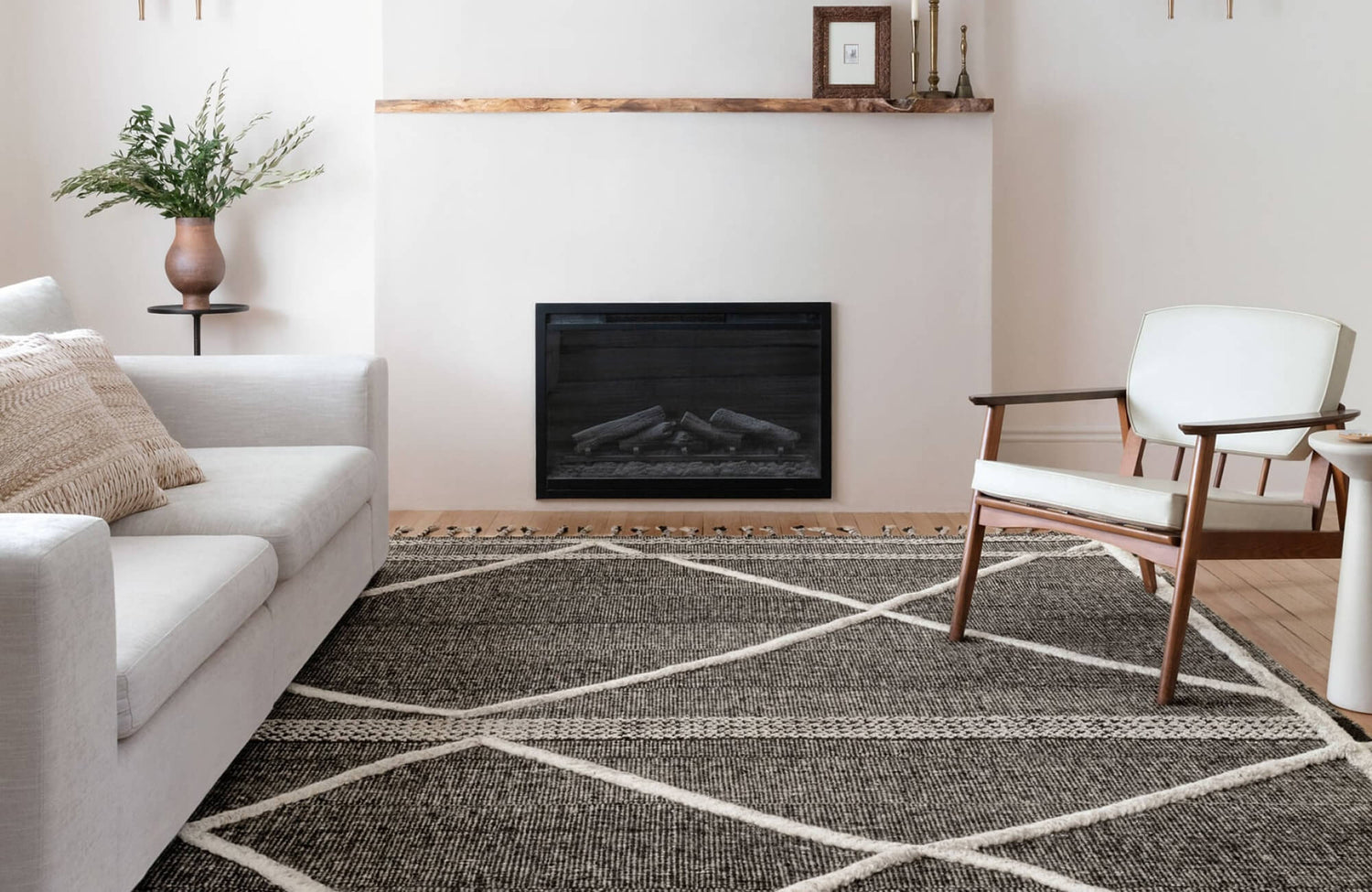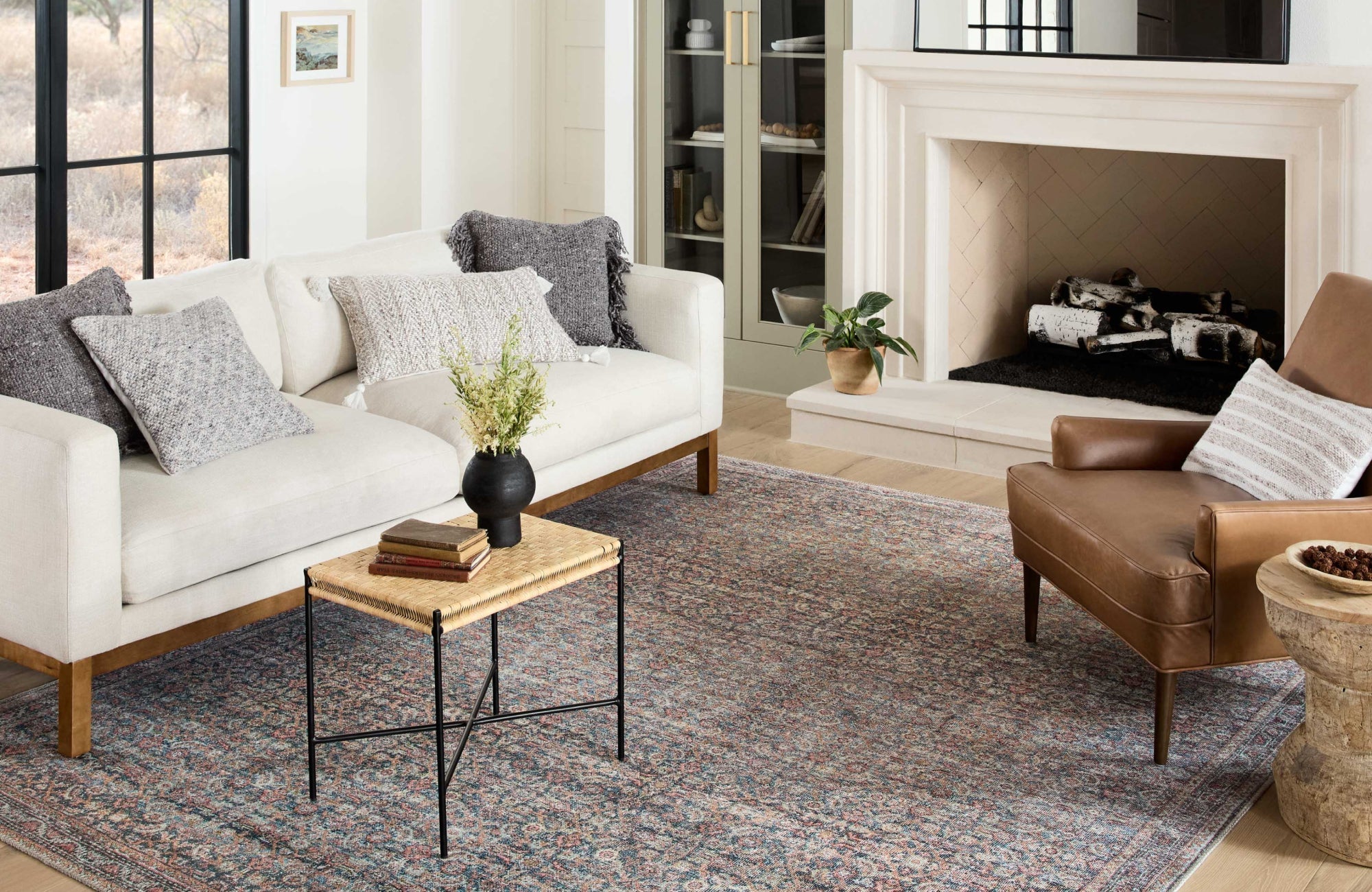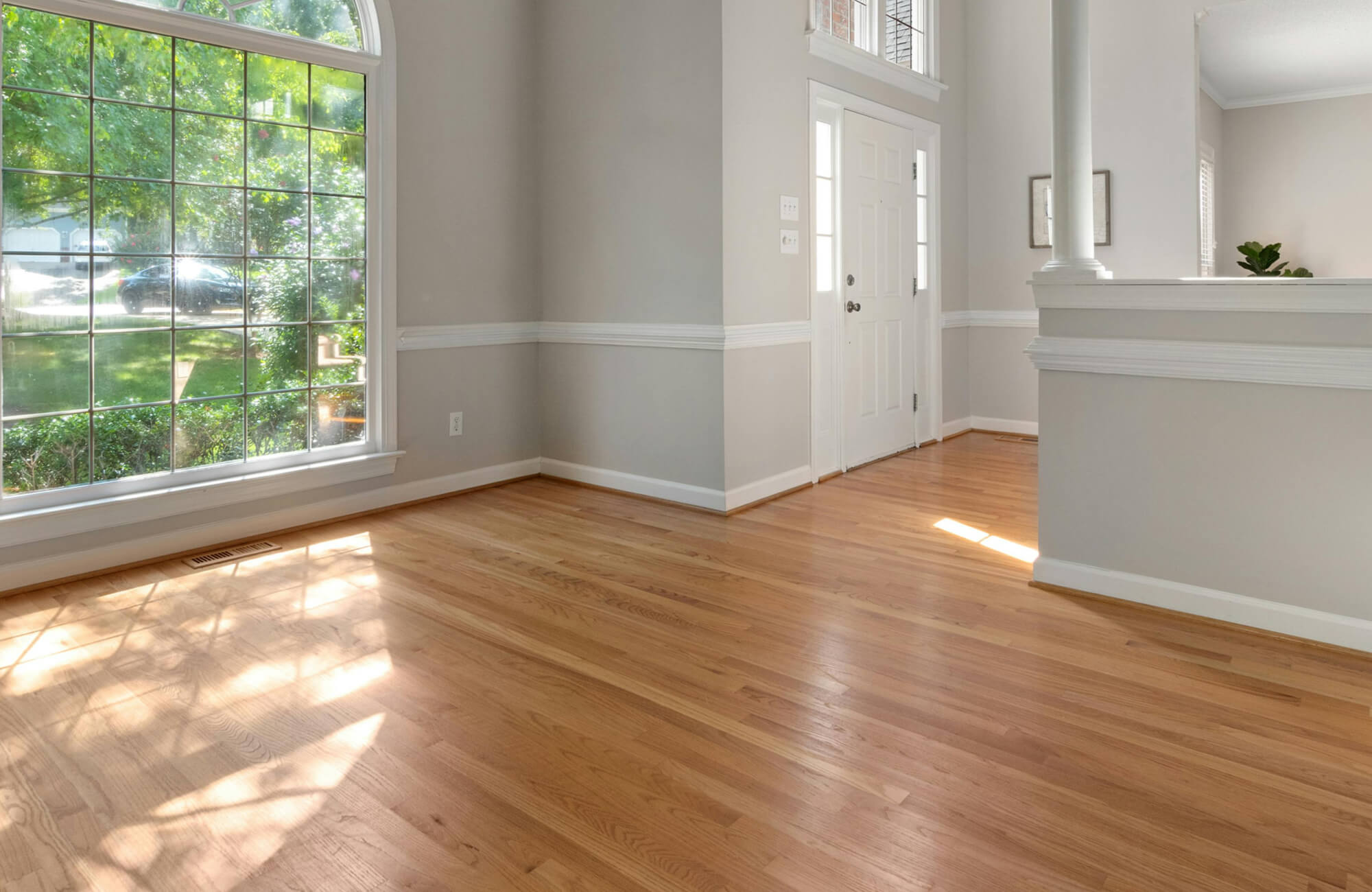A seemingly simple question, yet the difference between a rug and a carpet holds nuanced layers of history, function, and construction. Although both serve as floor coverings, their distinctions go beyond size and placement. Factors such as manufacturing techniques, materials, cultural significance, and functional applications also all play a role in defining how these textiles are categorized.
This article explores the core differences between rugs and carpets, examining their construction methods, historical evolution, functional roles, and market positioning. Whether you’re looking to furnish a space, understand design trends, or appreciate the craftsmanship behind these textiles, this comprehensive analysis will help you distinguish between the two and make informed choices.
Defining the Core Construction Method
Rugs and carpets differ significantly in their construction, influencing how they function, their durability, and their suitability for various spaces.
Woven Integration vs. Independent Layering
One of the most fundamental differences between carpets and rugs lies in how they interact with the space they occupy. Unlike rugs, carpets are designed to be a permanent flooring solution, seamlessly covering an entire room from wall to wall. They are also typically secured to the subfloor using tack strips, adhesives, or stretch fitting, ensuring they stay firmly in place over time.
For example, broadloom carpets, the most common type of wall-to-wall carpeting, are woven on large industrial looms in continuous rolls. This allows for expansive coverage without visible seams. At the same time, this integration creates a cohesive aesthetic and makes a room feel more uniform and insulated. It also helps reduce noise and provides added warmth underfoot. Because carpets are intended to be a fixed part of the flooring, removing or replacing them requires professional assistance, making them a more long-term investment.
In contrast, rugs offer a more flexible and adaptable approach to flooring. Rather than being affixed to the subfloor, they function as independent textile pieces that can be repositioned or removed with ease. This also makes rugs a versatile option for defining spaces within a room, adding texture, color, and visual interest without permanently altering the floor. Moreover, their mobility allows you to switch them between rooms, layer them over different flooring types, or store them away when not in use. Because they are not permanently installed, rugs provide an easy way to refresh a space, allowing you to experiment with different styles without the commitment of wall-to-wall carpeting.
Backing Materials and Edge Treatments
Another defining characteristic that separates rugs from carpets is the structure of their backing and how their edges are finished. Unlike rugs, carpets rely on a multi-layered backing system that provides dimensional stability, ensuring they remain taut and secure underfoot. Many carpets also use a dual-backing system, with a primary backing that holds the carpet fibers in place and a secondary backing that reinforces the structure.
In some cases, commercial carpets incorporate fiberglass or thermoplastic elastomers to enhance durability, prevent wrinkling, and resist moisture. Due to this added stability, carpets are particularly suited for busy areas such as hotels, offices, and retail spaces, where long-term wear resistance is essential. Additionally, since carpets are installed as part of the floor itself, their edges are typically hidden under baseboards or seamlessly joined to adjacent flooring materials, eliminating the need for decorative edge treatments.
On the other hand, rugs require edge treatments that not only prevent fraying but also contribute to their visual appeal. The way a rug’s edges are finished plays a crucial role in both its longevity and aesthetic refinement. For example, hand knotted rugs often feature a selvedge edge, where the weft threads are tightly secured through overcast stitching or a kilim end, reinforcing the rug’s structure and preventing unraveling.
In addition, some traditional rugs, particularly those crafted in Persian and Oriental styles, incorporate decorative fringes that extend from the warp threads. Although these fringes serve an ornamental purpose, they also help maintain the integrity of the rug’s weave. On the contrary, machine-made rugs are commonly finished with serging, a process in which a thread is wrapped around the edges to create a polished, finished look that prevents wear. Whether a rug is finished with a fringe, selvedge, or serging, these techniques ensure that it maintains its shape and durability over time.

Historical Evolution and Cultural Significance
Throughout history, rugs and carpets have evolved beyond simple floor coverings to become symbols of identity, status, and artistic craftsmanship. Their designs, materials, and functions have also been shaped by cultural traditions, societal changes, and historical influences, making them far more than just decorative elements in a space.
Nomadic Origins of Rugs vs. Fixed Dwellings of Carpets
Rugs trace their origins to nomadic cultures, where survival depended on portability and adaptability. As tribes migrated across vast landscapes, they required versatile textiles that could be easily transported, offering insulation from harsh climates while also serving as decorative and symbolic pieces. These early rugs were typically woven from locally available materials such as wool, which provided warmth and durability, or animal hides for added protection against the elements.
The weaving process itself also became a form of storytelling, with geometric patterns and tribal motifs reflecting ancestral traditions, personal histories, and cultural identity. Kilims, for example, were not only lightweight and easily rolled but also incorporated meaningful symbols that conveyed messages about the weaver’s heritage and beliefs. Today, this tradition lives on in high-quality wool rugs like Edward Martin’s Mallory Wool Pile Rug in Ocean, featuring rich blue and gray tones that seamlessly blend time-honored craftsmanship with modern aesthetics.
As civilizations transitioned from nomadic lifestyles to permanent settlements, carpets took on a different role. No longer designed for mobility, they became integral to architectural spaces, adorning palatial floors and signifying wealth, refinement, and social status. Unlike the simple, transportable rugs of nomadic groups, these carpets were often grand in scale, made with more intricate weaving techniques and using luxurious materials such as silk and finely spun wool.
Persian carpets, for example, emerged as artistic masterpieces, featuring elaborate floral and medallion motifs dyed with rich, natural pigments. These carpets were not merely decorative but also functioned as prized possessions, sometimes even used as diplomatic gifts to strengthen political alliances. Moreover, the shift from portable rugs to fixed carpets parallels the broader evolution of human civilization, reflecting the transition from transient communities to structured societies with grand architectural ambitions.
Regional Variations and Symbolism
Across the world, different cultures have infused their traditions, artistry, and beliefs into the rugs and carpets they produce, making each piece a unique representation of its origin. In the Middle East, for instance, Turkish prayer rugs, known as seccades, hold deep religious significance, with their designs centered around a mihrab, the arched motif that mimics the prayer niche found in mosques. These rugs are not only practical, providing a designated space for prayer, but also spiritual, guiding worshippers toward Mecca. The meticulous craftsmanship, vibrant colors, and natural dyes such as deep blues from indigo and reds from madder root highlight the artistic heritage and devotion woven into each piece.
In contrast, European carpets developed with a focus on luxury and refinement, catering to the tastes of aristocracy. Take for example, the French Savonnerie and Aubusson carpets were not just floor coverings but artistic expressions, featuring intricate floral arrangements, mythological themes, and elaborate borders. Crafted from silk and fine wool, these carpets were also designed to complement lavish interiors, often used in royal residences and grand estates.
Meanwhile, Persian carpets, known for their high knot density and sophisticated patterns, often incorporated motifs such as the boteh, a teardrop-like shape symbolizing fertility and life, or intricate arabesques representing infinite beauty and harmony. Similarly, in Chinese and Oriental carpets, designs featuring dragons and phoenixes conveyed power, prosperity, and balance, reinforcing cultural narratives within each weave.

Functional Applications and Spatial Impact
Rugs and carpets influence not only the appearance of a space but also its functionality and overall atmosphere. Whether used for full-room coverage or as decorative accents, these floor coverings play a key role in defining areas, enhancing comfort, and improving acoustics.
Room-Sized Coverage vs. Defined Area Accentuation
As mentioned, carpets are designed to cover entire floors, creating a seamless and uniform surface that contributes to both aesthetic and practical benefits. In commercial settings like offices, hotels, and conference rooms, carpets help absorb sound, reducing echoes and enhancing speech clarity. This makes them particularly valuable in large, open spaces where noise control is a priority. Their dense fiber structure also provides a layer of insulation, helping to regulate indoor temperature by retaining heat in colder months and keeping spaces cooler in the summer. In residential environments, carpets can make a room feel more cohesive by eliminating visual breaks in the flooring, making smaller areas appear larger and more unified. Their underfoot softness also enhances comfort, especially in spaces where you spend a lot of time standing or walking.
Rugs, on the other hand, serve as more than just floor coverings. They act as design elements that define specific areas within a space. A well-placed area rug can anchor furniture in a living room, create a cozy atmosphere in a bedroom, or add warmth and texture to a dining space. In bedrooms, in particular, a thoughtfully chosen rug enhances comfort while tying together the overall aesthetic. Just like the blend of soft green and deep gray tones of our Hutchinson Polyester Face Rug in Sage Graphite, seen in the serene bedroom setting in the above photo, the right rug can introduce intricate patterns, soft textures, and a sense of refinement to the space. The vintage-inspired design of this rug also complements the neutral tones of the bedding and furniture, creating a harmonious blend of sophistication and relaxation.
Practicality and Maintenance Considerations
The long-term performance and visual appeal of carpets and rugs largely depend on their maintenance requirements. Since carpets cover large areas, they tend to accumulate dust, dirt, and allergens more quickly, making consistent upkeep essential for maintaining cleanliness. Regular vacuuming plays a crucial role, especially in busy areas where dirt and debris can become deeply embedded in the fibers. In commercial spaces, where foot use is constant, professional cleaning methods such as hot water extraction or dry cleaning are also necessary to extend the carpet’s lifespan and prevent premature wear. Additionally, many modern carpets are designed with stain-resistant treatments or made from synthetic fibers like nylon or polyester, which enhance durability and improve resistance to spills. Despite these advancements, carpets can still be difficult to deep clean, as stains may penetrate the fibers if not addressed promptly.
On the other hand, rugs are generally easier to maintain due to their smaller size, especially those made from durable, stain-resistant materials such as the Charlise Polypropylene Polyester Pile Rug in Indigo Dune, a blend of deep blue and sandy beige tones that complements various interiors. However, their care requirements vary depending on their material and construction, which can influence both cleaning methods and long-term durability. For instance, high-pile rugs, such as shag or plush designs, require careful vacuuming to prevent the fibers from matting, whereas flatweave rugs are a more practical, low-maintenance option that can be cleaned with minimal effort. Additionally, handmade rugs, especially those crafted from natural fibers like wool or silk, demand delicate handling to prevent damage. In many cases, professional cleaning is recommended for antique or handwoven pieces to preserve their intricate patterns and fiber integrity.
Beyond maintenance, another major advantage of rugs is their portability. Unlike carpets, which are permanently fixed, rugs can be easily removed for cleaning, shaken out to remove dust, or taken to a professional cleaner when needed. This flexibility also makes replacement far more convenient. If a rug becomes too worn or stained, swapping it out is much simpler and more cost-effective than the labor-intensive process of removing and reinstalling a carpet.
Market Differentiation and Consumer Perception
The way rugs and carpets are marketed plays a significant role in how you perceive and choose between them. Pricing, branding, and customization options not only determine their accessibility but also shape their role in interior spaces. While carpets are often associated with large-scale installations, rugs are viewed as individual design elements, offering more flexibility and personalization.
Retail Categorization and Pricing Strategies
Carpets are primarily sold as a flooring solution, typically measured by the square yard or meter. The cost varies widely depending on material, construction, and durability. Wool carpets, for instance, command a higher price due to their natural resilience, softness, and sustainability, often ranging from $5 to $26 per square foot. In contrast, synthetic options like nylon or polyester provide a more affordable alternative, typically costing between $2 and $7 per square foot, with added benefits such as stain resistance and ease of maintenance. Additionally, modular carpet tiles, which range from $1 to $8 per square foot, have gained popularity in commercial spaces by offering a customizable, budget-friendly option that simplifies installation and replacement.
Rugs, on the other hand, are marketed as individual decor pieces, making their pricing structure more diverse. Unlike carpets, which are sold in continuous rolls, rugs are priced based on factors such as size, craftsmanship, and material quality. For those seeking a budget-friendly option, mass-produced rugs made from synthetic fibers provide an affordable solution, with small area rugs starting at around $20 to $100.
Meanwhile, larger machine-made rugs typically range from $150 to $800, depending on the design and brand. However, for those looking for superior craftsmanship and longevity, high-quality hand knotted wool rugs can range from $1,000 to $10,000 or more. At the highest end of the market, rare Persian or silk rugs can exceed $50,000 due to their intricate weaving techniques, use of natural fibers, and deep cultural significance. Furthermore, the exclusivity of luxury rugs is reinforced by designer collaborations and limited-edition collections, positioning them as statement pieces rather than purely functional floor coverings.
Design Trends and Customization Options
The evolution of design trends has significantly influenced the way rugs and carpets are produced and marketed. Carpets, once primarily valued for their durability and function, are now being designed with aesthetics in mind. Advances in fiber technology have also introduced textured patterns, bold colors, and intricate designs that allow carpets to make a visual impact while maintaining their practical benefits. In addition, many modern carpets now feature modular designs, where different patterns and colors can be mixed and matched to create a fully customized look. In commercial settings, customization is often centered around branding and functionality, with corporate offices choosing carpets that reflect their brand identity and also enhance acoustics and comfort.
Rugs, however, have become a key focal point in interior design, with customization options extending far beyond color and pattern. In recent years, the resurgence of artisanal craftsmanship has sparked renewed interest in handwoven and bespoke rugs, allowing you to select specific fibers, weaves, and finishing details to match your style. At the same time, natural and organic textures have gained popularity, with rugs made from materials like jute, sisal, and undyed wool becoming sought-after for their eco-conscious appeal. The growing emphasis on sustainability has also led to innovations such as rugs crafted from recycled materials or plant-based dyes, offering a balance between beauty and environmental responsibility.
Choosing Between Rugs and Carpets for Your Space
Rugs offer unmatched versatility, allowing you to redefine a space effortlessly with minimal commitment, whether by adjusting layouts, layering over different flooring types, or adding warmth and texture. Their wide range of materials and designs makes them an easy way to refresh a room while being simpler to clean, move, or replace compared to carpets. In contrast, carpets provide a seamless, wall-to-wall flooring solution that enhances insulation, reduces noise, and creates a cohesive aesthetic. Though a durable and comfortable long-term investment, their fixed installation limits design flexibility and requires professional installation and removal.
If you're looking for expert guidance on selecting the perfect rug, Edward Martin offers a curated selection of custom and handcrafted pieces. Our expertise ensures a seamless experience in selecting a rug that enhances both aesthetics and functionality. Whether you need a timeless heirloom or a modern statement piece, our team provides personalized guidance to help you find the perfect fit for your space.









